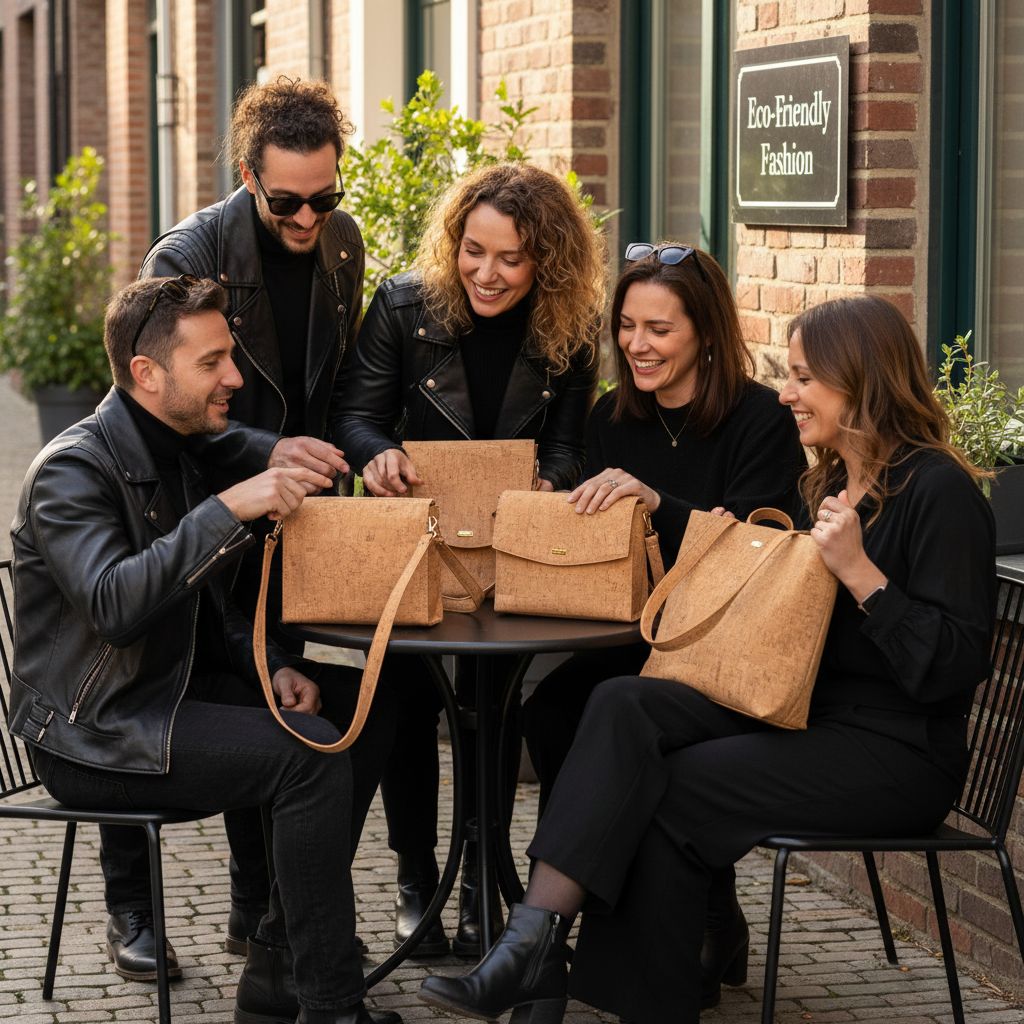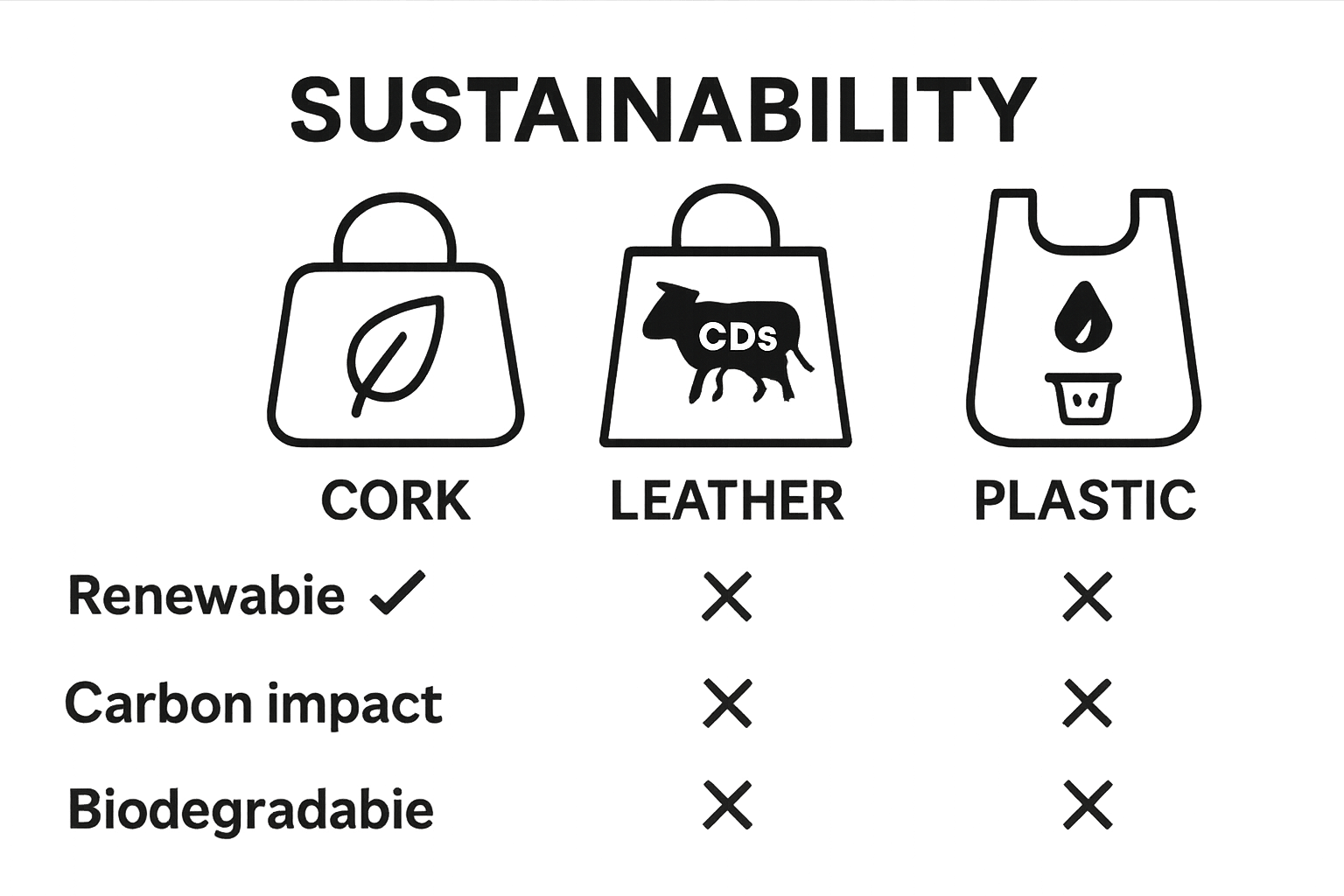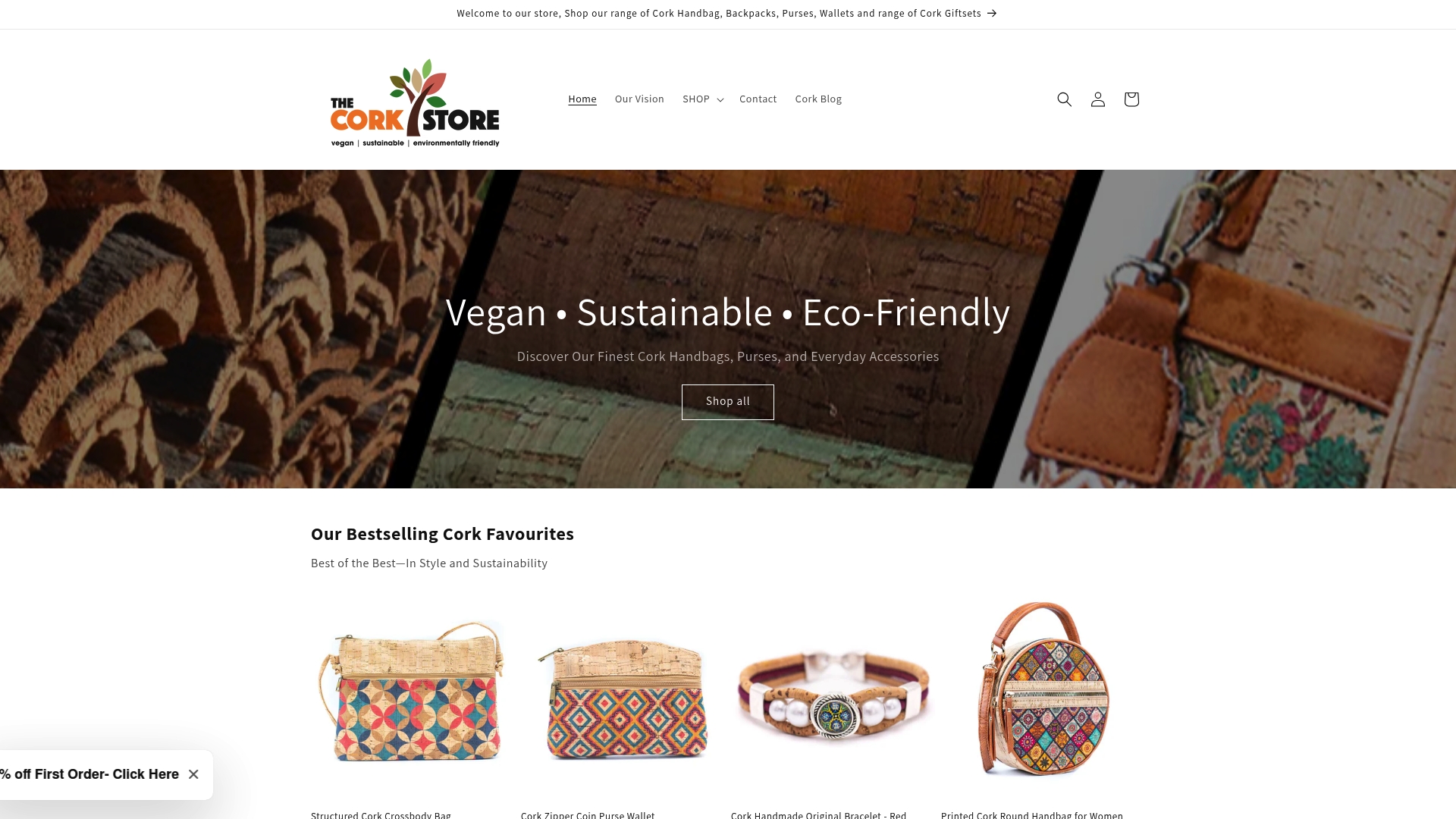
What is a Cork Bag? Understanding Eco-Friendly Fashion
Share
Cork bags are quickly gaining attention as the next evolution in sustainable fashion. Many people know cork as the stuff that tops a wine bottle, but only a handful realise that it makes for a stylish, vegan accessory with unexpected benefits. The real shock comes when you learn that cork oak trees can live for up to 300 years and be harvested every 9 to 12 years without harm, turning what seems like a simple handbag into a long-term environmental solution.
Table of Contents
- Defining Cork Bags And Their Material
- The Environmental Significance Of Cork Bags
- How Cork Bags Are Made: The Process
- Benefits Of Choosing Cork Bags For Your Wardrobe
- Cork Bags In The Broader Context Of Sustainable Fashion
Quick Summary
| Takeaway | Explanation |
|---|---|
| Cork bags are eco-friendly accessories. | Made from renewable cork oak, they minimize environmental impact compared to traditional materials. |
| Sustainable harvesting supports biodiversity. | Cork bark stripping does not harm trees, allowing them to continue absorbing carbon dioxide. |
| Cork bags are vegan and biodegradable. | Unlike leather, cork bags are completely plant-based and decompose naturally without harmful chemicals. |
| They offer unique health benefits. | Cork is hypoallergenic, making it a safe choice for individuals with allergies or sensitive skin. |
| Choosing cork supports ethical fashion. | Consumers can actively promote sustainability by opting for cork bags over synthetic or traditional leather products. |
Defining Cork Bags and Their Material
Cork bags represent an innovative and sustainable alternative in the fashion accessories landscape, offering eco-conscious consumers a unique material that combines functionality with environmental responsibility. Scientific research reveals cork as a remarkable natural material harvested from the bark of cork oak trees, which remarkably regenerates after harvesting.
What Exactly is a Cork Bag?
A cork bag is a fashion accessory crafted primarily from cork fabric, a lightweight and durable material created by adhering thin cork sheets to a textile backing. Unlike traditional leather products, cork bags are completely vegan and biodegradable. The material offers several distinctive characteristics that set it apart from conventional bag materials:
- Sustainable Origin: Derived from renewable cork oak tree bark
- Eco-Friendly Production: Minimal environmental impact during manufacturing
- Unique Aesthetic: Natural, textured appearance with modern appeal
The Science Behind Cork Fabric
The transformation of cork bark into a flexible, wearable fabric is a fascinating process. Textile engineering studies demonstrate that cork can be processed into thin, pliable sheets that maintain the material’s inherent properties. These sheets are carefully treated and bonded to create a fabric suitable for fashion accessories like bags, wallets, and backpacks.
For those keen to explore more about sustainable materials, learn more about cork’s role in ethical fashion. This innovative approach to bag design not only provides a stylish alternative to traditional materials but also contributes to reducing environmental impact in the fashion industry.
The Environmental Significance of Cork Bags
Cork bags represent far more than a fashion trend. They are a pivotal solution in addressing the fashion industry’s substantial environmental challenges, offering a sustainable alternative that minimises ecological impact. Environmental research demonstrates the critical role innovative materials like cork play in reducing carbon footprints and promoting responsible consumption.
Carbon Footprint and Sustainability
Unlike traditional leather production, which involves significant greenhouse gas emissions and deforestation, cork harvesting is remarkably sustainable. Cork oak trees are not cut down during bark extraction, allowing them to continue absorbing carbon dioxide and supporting biodiversity. The harvesting process actually stimulates tree growth and extends their natural lifecycle, making cork a regenerative material with remarkable environmental benefits:

- Zero Tree Damage: Bark is carefully removed without harming the tree
- Carbon Sequestration: Each harvested cork oak continues capturing atmospheric carbon
- Extended Tree Lifespan: Trees can be harvested every 9-12 years for up to 300 years
Waste Reduction and Circular Economy
Cork bags contribute significantly to the circular economy by offering a biodegradable alternative to synthetic materials. Circular economy experts highlight that cork products can decompose naturally without releasing harmful microplastics, unlike petroleum-based accessories. This approach directly addresses the growing concern of fashion waste and its long-term environmental consequences.
Discover more about sustainable fashion choices and how individual purchasing decisions can create meaningful environmental impact. By choosing cork bags, consumers actively participate in a global movement towards more responsible and eco-conscious fashion consumption.
How Cork Bags Are Made: The Process
The production of cork bags is a sophisticated process that transforms raw cork bark into elegant, durable fashion accessories. Manufacturing research reveals a meticulous journey from forest to finished product, highlighting the intricate craftsmanship behind these sustainable items.
Harvesting and Initial Processing
Cork bag production begins with sustainable harvesting of cork oak tree bark. Skilled workers carefully strip the bark without damaging the tree, ensuring the tree continues growing and absorbing carbon. The extracted bark undergoes several critical preparation stages:
- Selection: Choosing high-quality bark with minimal imperfections
- Boiling: Softening the bark to improve flexibility
- Drying: Stabilising the material for further processing
Transforming Cork into Fabric
The most innovative stage involves converting raw cork into a wearable textile. Skilled artisans slice the bark into incredibly thin sheets, which are then carefully bonded to a fabric backing. This process requires precision to maintain the material’s natural properties while creating a flexible, durable surface suitable for bag manufacturing.
Key manufacturing techniques ensure the cork fabric remains lightweight, water-resistant, and capable of withstanding daily use. Learn more about sustainable handbag manufacturing to understand the intricate processes that transform natural materials into sophisticated accessories. Each cork bag represents a harmonious blend of environmental consciousness and contemporary design, showcasing how sustainable practices can revolutionise fashion production.
To summarise the key stages, the table below outlines the main steps involved in transforming cork bark into a finished bag.
| Production Step | Description |
|---|---|
| Harvesting | Skilled removal of cork bark from trees without causing damage |
| Selection | Choosing high-quality bark with few imperfections |
| Boiling | Softening the bark to enhance flexibility |
| Drying | Stabilising the cork material for processing |
| Slicing | Cutting bark into thin, workable sheets |
| Bonding | Adhering cork sheets to a fabric backing to create cork fabric |
| Assembly | Constructing bags using tailored cork fabric and skilled craftsmanship |
Benefits of Choosing Cork Bags for Your Wardrobe
Cork bags have emerged as a sophisticated and intelligent choice for modern, environmentally conscious consumers seeking accessories that marry style with sustainability. Scientific research confirms that these innovative accessories offer remarkable advantages beyond traditional fashion materials.
Practical Performance and Durability
Unlike conventional leather or synthetic bags, cork bags provide exceptional functional benefits that enhance their everyday usability. The material’s inherent properties make it an outstanding choice for discerning individuals who demand both performance and aesthetic appeal:
- Water Resistance: Natural protective layer repels moisture effectively
- Lightweight Construction: Significantly lighter than traditional leather bags
- Exceptional Durability: Maintains structural integrity through prolonged use
Health and Aesthetic Advantages
Cork bags offer unique health and style benefits that set them apart from mainstream accessories. Textile innovation studies highlight their hypoallergenic properties, making them an excellent option for individuals with sensitive skin or allergies. The material’s distinctive texture provides a sophisticated, natural appearance that complements various fashion styles.
Discover styling tips for cork accessories and elevate your fashion choices with these remarkable sustainable pieces. By selecting cork bags, you are not just making a fashion statement but also supporting ethical, environmentally responsible manufacturing practices that contribute to global sustainability efforts.

Cork Bags in the Broader Context of Sustainable Fashion
Sustainable fashion represents a profound transformation in how consumers and designers approach clothing and accessories, with cork bags emerging as a pioneering example of innovative, environmentally responsible design. Research in sustainable textiles indicates that these accessories are more than mere fashion statements they represent a fundamental shift in textile production and consumption.
Challenging Traditional Fashion Paradigms
Traditional fashion industries have historically prioritised aesthetics and cost over environmental considerations. Cork bags challenge these conventional approaches by demonstrating that sustainable materials can be simultaneously stylish, functional, and ecologically responsible. This paradigm shift involves reimagining fashion through a lens of environmental stewardship:
- Material Innovation: Replacing petroleum-based synthetics with renewable resources
- Ethical Production: Prioritising low-impact manufacturing processes
- Circular Design: Creating products that can be recycled or naturally decompose
Global Impact and Consumer Consciousness
The rise of cork bags reflects a broader global movement towards more mindful consumption. Consumers are increasingly recognising that their purchasing decisions have substantial environmental implications. By choosing accessories like cork bags, individuals participate in a larger ecosystem of sustainable fashion that challenges existing production models and promotes responsible resource utilisation.
Learn about the role of eco-friendly materials in fashion and understand how each accessory choice contributes to a more sustainable future. Cork bags symbolise more than a trend they represent a meaningful commitment to environmental preservation and conscious consumerism.
Ready to Make Eco-Friendly Fashion a Reality?
You have just learned how cork bags offer a genuine solution to the environmental harm and waste of conventional fashion. If you care about sustainability and want to break free from harmful materials, why not make your next accessory both stylish and responsible? At The Cork Store, you will find a handpicked range of vegan cork handbags, wallets, and accessories designed for those who value the planet as much as their style.

Experience the difference of products that are water resistant, lightweight, and biodegradable. Do not wait to make a more ethical choice. Explore our collection at The Cork Store and take the first step towards a sustainable and cruelty free wardrobe. For more inspiration on cork’s role in sustainable fashion, visit our resource on understanding the role of cork in sustainable fashion and discover how your choices shape a better future.
Frequently Asked Questions
What are the benefits of using cork bags?
Cork bags offer several benefits, including durability, water resistance, and lightweight construction. They are also hypoallergenic, making them suitable for sensitive skin, and they maintain their structural integrity over time, proving to be an excellent choice for everyday use.
How are cork bags made?
Cork bags are produced through a meticulous process that begins with sustainable harvesting of cork oak bark. The bark is boiled, dried, and then sliced into thin sheets, which are bonded to a fabric backing to create a flexible and durable material suitable for bag manufacturing.
Are cork bags environmentally friendly?
Yes, cork bags are environmentally friendly. The cork is harvested from trees without causing damage, allowing them to continue growing and absorbing carbon. Additionally, cork bags are biodegradable and contribute to reducing waste in the fashion industry, promoting a circular economy.
How do cork bags compare to traditional leather bags?
Cork bags differ from traditional leather bags in several ways. They are vegan, biodegradable, and produced with minimal environmental impact. Unlike leather, cork does not involve harmful chemicals during production and is more sustainable due to the regenerative nature of cork oak trees.
To provide a clear comparison, the following table distinguishes between cork bags and traditional leather bags across key sustainability and performance factors.
| Feature | Cork Bags | Traditional Leather Bags |
|---|---|---|
| Material Source | Bark of cork oak trees (renewable) | Animal hides |
| Environmental Impact | Minimal, regenerative harvesting | High, involves deforestation and chemicals |
| Vegan | Yes | No |
| Biodegradable | Yes | No |
| Production Chemicals | Minimal, non-toxic | Often involves toxic tanning compounds |
| Water Resistance | Naturally water-resistant | Usually requires treatment |
| Weight | Lightweight | Heavier |
| Hypoallergenic | Yes | No |
